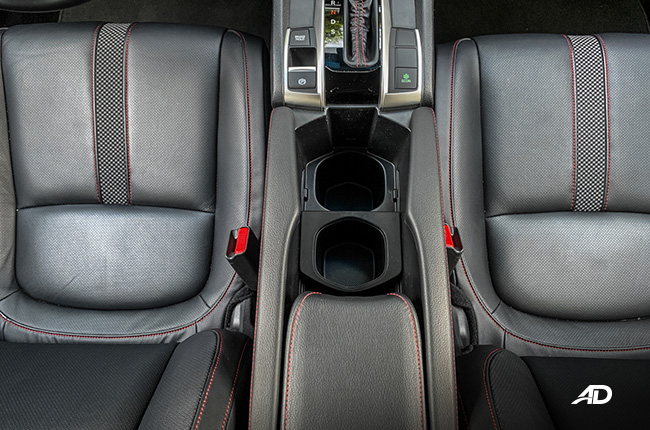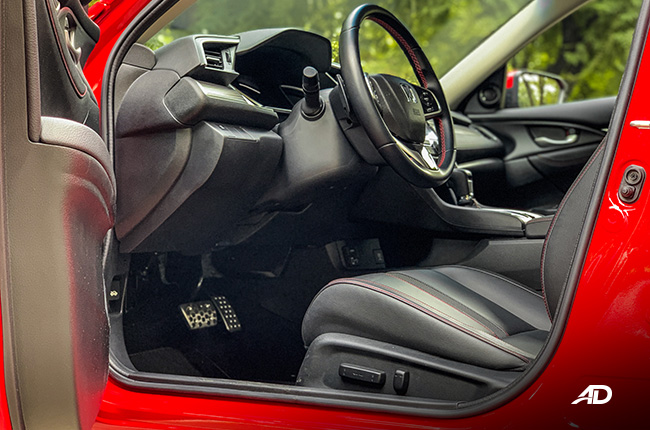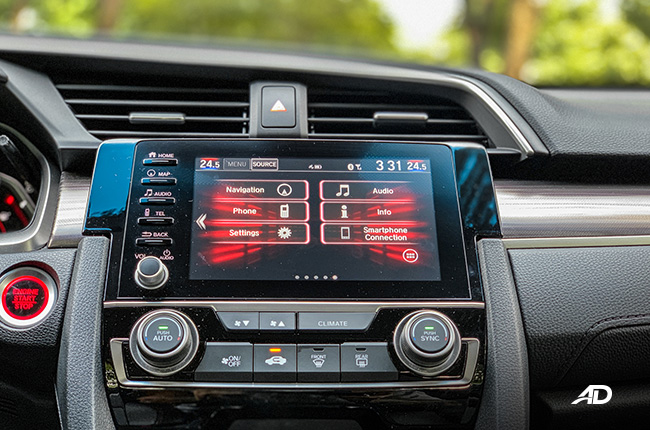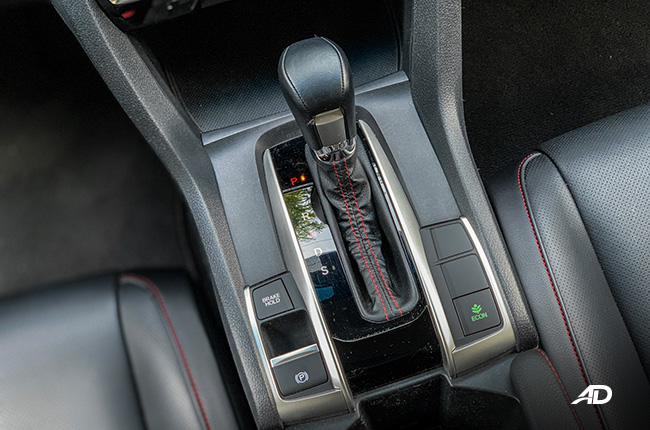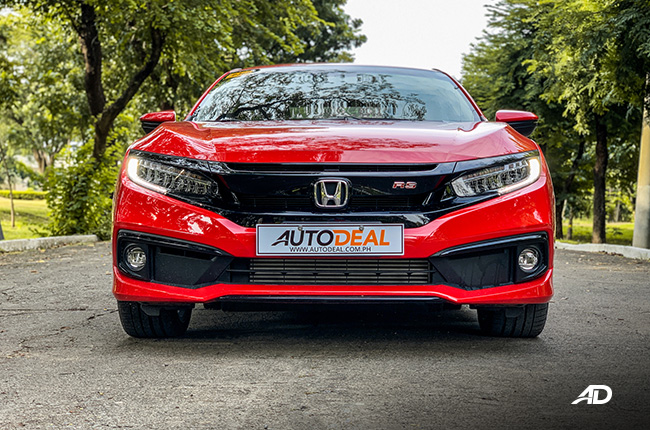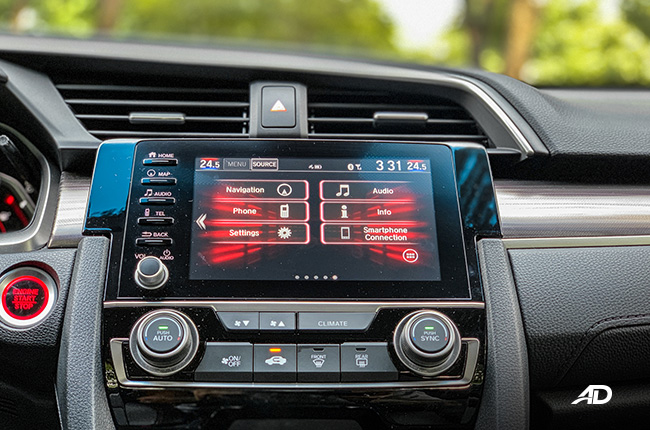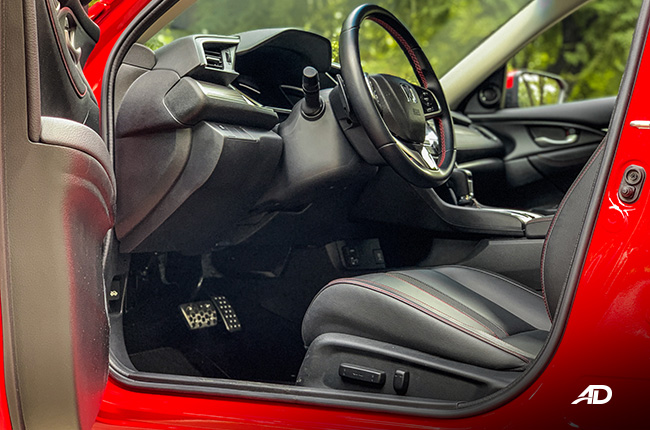
Contents
It has been more than three years now since Honda Cars Philippines launched the 10th-generation Honda Civic. But until now, the sight of a Civic on the road doesn’t hurt my eyes as much as other mainstream cars do. That holds true even with the introduction of other sedan options out there, which saturates the market for those looking for a low-riding, compact family vehicle.
In short, the Civic remains an edgy sedan that’s designed to stand out. This year, HCPI gave it a very minor refresh inside and out, and here’s our Honda Civic RS Turbo review based on the changes employed by the marque.
Engine Output (HP), Acceleration, Transmission, Handling 4.0/5
Exterior & Interior Design, Quality, Fit and Finish, Ergonomics 4.5/5
Cabin Comfort, Suspension, NVH Insulation 4.0/5
Convenience Technologies, Active and Passive Safety Features 4.0/5
Amount of the vehicle you get for the price, Fuel Efficiency 3.5/5
- Above-average driving dynamics.
- Cavernous interior space.
- Interior updates gave the car a better in-cabin feel.
- Pricing’s a bit steep.
- Scratch-prone piano black plastics on key touchpoints.
Exterior
While the more affordable Honda Civic E gears towards being classy rather than sporty, the Civic RS Turbo has a full-on athletic design even with just color differences from the former. The RS Turbo is adorned with a shiny black grille, an 18-inch RS Design Black alloy wheels, and a wing-type spoiler. These replace the shiny stuff you’d find on the lower variant, giving the RS Turbo a sporty edge in terms of looks.
For its facelift, the Civic RS Turbo gets a continuous block of black lower grille that flanks across the foglamp casings. Plus, the LED DRLS, headlights, and fog lights make the car look really good at night. The outside changes are minute but a good-looking car doesn’t really need too much update, does it? And besides, as I’ve mentioned previously, the 10th-generation Civic’s looks aren’t getting older – just yet.
If there’s any qualm, I’m not a fan of the screaming Rallye Red paint scheme of the media unit. But if that’s your cup of tea, you do you.
Interior
The sportiness of the Civic’s exterior design transcends into the cabin, primarily because of the checkered accents on the leather seats that are partnered with red stitchings. There’s also more depth inside the vehicle, primarily because of the red stitchings and graphic adornments found on the dashboard and door cards. With these updates, the new Civic RS Turbo is livelier than before, which, in combination with the low seating position and well-bolstered seats, elevates the engaging feel behind the steering wheel. The red ambient lighting is the final recipe to the mix, which matches the media unit’s exterior color.
Although, I would like to point out that the updated Civic’s dashboard is a bit tall this time around, so positioning yourself in the lowest seating position would mean less visibility. Nevertheless, other sensibilities inside the cabin like buttons, knobs, cubbyholes, and cupholders are well thought out – including the hidden USB, 12V, and HDMI ports underneath the central tunnel.
Comfort

The Civic RS Turbo’s ride is a bit stiffer than the lower variants primarily because of the bigger set of rims that this car has. It remains flexible, though, and going over unforgiving thoroughfares. What you will like, however, is the less pliancy on winding roads, which can give you better control when tackling curves at speeds. You can also thank the Civic’s relatively low center of gravity for that.
As for space, the Civic has lots of it even at the back. Three healthy people on the rear seats would limit each individual’s privacy, but it won’t be a squeeze. Air conditioning works sufficiently even during hotter parts of the day. And yes, even without the rear A/C vents.
Trunk space defaults at 519L – big enough for a standard-size child stroller and one month-worth of groceries.
Technology
As a range-topper, the Civic gets all the bells and whistles that Honda could offer in a compact sedan. A digital instrument cluster will greet you upon ignition, plus the Apple CarPlay/Android Auto-capable 7-inch touchscreen infotainment now has tactile knobs and buttons for easier operation. Kudos to Honda for that.
Other convenient features include an 8-way motorized adjustment for the driver, auto up-down windows for the front occupants, auto on/off headlights, auto-folding side mirrors, remote start, speed-sensing door locks, rain-sensing wipers, reverse camera with guidelines, electronic parking brake with auto-brake hold, and auto-dimming rearview mirrors.
Everything works seamlessly and without any gripe. But with newer segment rivals getting radar-based features this year, I can’t help but wonder if Honda will ever add Honda Sensing on its compact sedan offering, considering that its rivals are similarly priced, if not lower.
Safety

Just like its convenient features, the Civic RS Turbo is also filled to the brim with safety toys. Standard in this variant are dual front, side, and curtain airbags, ABS with EBD, vehicle stability control, ISOFIX child seat tethers, and seatbelt reminders for the front occupants.
Security, on the other hand, is taken care of by immobilizer, alarm, and walk-away automatic lock. The latter is a heaven-sent feature since it takes out the anxiety of remembering whether you were able to lock your car or not.
Driving & Handling

Without any engine update for this year, the Civic RS Turbo retains its spritely yet controlled performance on the road. The turbocharged 171-hp 1.5L DOHC VTEC provided a healthy portion of the 220 Nm torque as early 1,700 RPM.
Within the city, the car wasn’t lazy and remained obedient at any driving conditions. However, the proprietary Earth Dreams CVT, although better than most CVTs out there, held back what the car could possibly do out in the open. Changing speeds would warrant frequent use of paddle shifters, but that’s fine as they’re almost on point in simulating gears for the car to use. Almost, but not quite.
The Civic RS Turbo handled better than its naturally-aspirated counterpart, primarily because of its stiffer ride. Body roll was present on fast corners but one that wasn’t expected. After all, the Civic is still a mainstream family sedan, no matter how sporty it looks. With that said, maneuverability within tight streets was a cinch because the car didn’t feel huge at all and the steering feels light – even too light sometimes.
Fuel Efficiency

Honda’s use of Earth Dreams CVT is primarily for better fuel economy, and it didn’t disappoint me during the review. Amidst heavy city traffic, the Civic RS Turbo read back 8.3 km/L while averaging 15 km/h. Faster Sunday drives, on the other hand, gave back 13.4 km/L with an average speed of 60 km/h. The compact sedan was most frugal on the highway at 18.6 km/L with the cruise control nailed at 90 km/h.
Verdict

The updates this year gave the 2019 Honda Civic RS Turbo a fresh look, a better in-cabin feel, and sadly, a higher price tag. At P1,608,000, Honda’s compact sedan is a victim of heightened excise tax rates. Crossing the P1.6-million mark didn’t do the car any favor, especially for the budget-conscious Filipino car buyers.
But then again, a storied nameplate that looks and drives this good is hard to dismiss, and I’m pretty sure a lot of its fans would agree.
2019 Honda Civic RS Turbo Exterior Photo Gallery
2019 Honda Civic RS Turbo Interior Photo Gallery
Specifications
Engine
n/aFuel Type
GasolinePerformance
n/aTransmission
Automatic-
Summary
-
Name Honda Civic RS Turbo AT Body Type Sedan Price PRICE ON REQUEST Transmission Category Automatic -
Engine
-
Engine Size n/a Displacement n/a Number of Cylinders n/a Number of Valves n/a Transmission Type -
Performance
-
Drivetrain n/a Max Output (hp) n/a Max Torque (nm) n/a -
Economy & Environment
-
Fuel Type Gasoline Emissions Standard n/a Fuel Capacity n/a Combined Fuel Consumption n/a -
Dimensions
-
Length n/a Width n/a Height n/a Wheelbase n/a Turning Circle n/a Ground Clearance n/a Trunk Capacity n/a Number of Doors 4 Number of Seats 5 -
Safety & Security
-
Driver's Airbag Front Passenger's Airbag Side Airbag Curtain Airbag Knee Airbag Auto Brake System Electronic Brake Distribution Anti-lock Brake System (ABS) Immobilizer Security Alarm Stability Control Electronic Door Locks Speed Sensing Door Locks ISOFIX Lane Departure Warning System Blind-Spot Detection System -
Features
-
Cruise Control Front Parking Sensors Rear Parking Sensors Leather Upholstery Push Start Button Wheel Size n/a Wheels Metal Type n/a Airconditioning System n/a Entertainment System n/a Connectivity n/a Navigation Ready Warranty n/a Keyless Entry Roof Rack Sunroof Electric Adjustable Seats Power Steering Power Windows Power Outlet Steering Wheel Audio Control -
Technology
-
Active Park Assist Hill Start Assist AWD Modes n/a Tire Pressure Monitoring Heads-up Display Power Liftgate Start-stop System
Colors
Latest Review
-
2025 BAIC B30e Dune 4x4 HEV Review / Review
After 1,000 km behind the wheel of the BAIC B30e Dune, we share what we loved about this hybrid and what we don’t.
4.2 / 5 -
2025 MG G50 Plus Lux DCT Review / Review
Can affordable price and VIP aspirations blend together? We find out in this review of the MG G50 Plus Lux DCT.
4.0 / 5 -
2025 BYD Seal 5 DM-i Premium Review / Review
We test-drove the BYD Seal 5 DM-i, and its features and affordable price make it a strong hybrid sedan contender.
4.2 / 5
Popular Articles
-
Cheapest cars under P700,000 in the Philippines
Jerome Tresvalles · Sep 02, 2024
-
First car or next car, the Ford EcoSport is a tough package to beat
Jun 18, 2021
-
Car Maintenance checklist and guide – here’s everything you need to know
Earl Lee · Jan 12, 2021
-
Most fuel efficient family cars in the Philippines
Bryan Aaron Rivera · Nov 27, 2020
-
2021 Geely Okavango — Everything you need to know
Joey Deriquito · Nov 19, 2020
-
Family cars in the Philippines with the biggest trunks
Sep 20, 2023
-
Head to head: Toyota Rush vs. Suzuki XL7
Joey Deriquito · Oct 28, 2020
-
Why oil changes are important for your car
Earl Lee · Nov 10, 2020
-
2021 Kia Stonic — What you need to know about it
Joey Deriquito · Oct 16, 2020
-
Top 7 tips for buying a used car in the Philippines
Joey Deriquito · Nov 26, 2020





